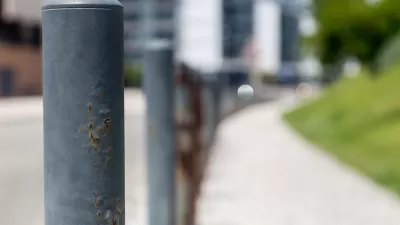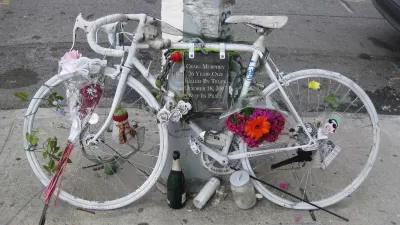Cable news networks interrupted broadcasts on Thursday morning with breaking news: a vehicle had just driven three block on the sidewalks in Times Square, New York, resulting in massive casualties. Anchors asked, "Was it terrorism or an accident?"
News hosts could initially only report on the horrific incident with graphic pictures, videos, and on-street interviews, but only speculate as to the cause, while recounting recent incidents abroad where motor vehicles had been used by terrorists to cause massive deaths and injuries.
"The speeding car jumped the sidewalk on the west side of 7th Avenue at 42nd Street and barreled into pedestrians for three blocks before crashing at the northwest corner of 45th Street," reported Ray Sanchez for CNN. "An 18-year-old woman was killed and at least 22 people injured..."
Paul Steely White, executive director of New York City-based Transportation Alternatives, takes it from here in an opinion in the Daily News published Friday.
But when news emerged that what happened in Times Square was not an act of terrorism, instead of breathing a sigh of relief, those of us in the safe streets movement could only shake our heads: It had happened again.
The driver, "Richard Rojas, 26, of the Bronx -- tested positive for PCP and told police that God made him do it, a law enforcement source told CNN," reported Sanchez. [See Planetizen: DUIDs Surpass DUIs as Cause of Fatal Vehicle Crashes.] "The Post reported that it was an attempt of "suicide by cop."
Cars jumping sidewalks and hitting pedestrians is not new. "Pedal misapplication," by definition, may not be intentional, but the effects are just as tragic and is sadly a regular occurrence. And vehicles used by deranged drivers, but not terrorists, to hit, main, and kill pedestrians and cyclists, in not new.
Yet despite this historic pattern of innocent pedestrians mowed down by drivers making deadly or sociopathic choices, and scores more throughout the rest of the city, many reporters, elected officials and first responders referred to yesterday’s tragedy — and countless others — as “accidents.”
Last year, the death toll on America's roads exceeded 40,000, according to preliminary estimates by the National Safety Council. Politifact reported in October 2015 that 24 people in the United States had died due to terrorism within the last decade.
As the final picture of Thursday's carnage, the resting place of the Honda above a steel bollard, also referred to as a stanchion, clearly illustrated, the casualty toll could have been much greater.
To prevent further loss of life, in the wake of yesterday’s tragedy we must realize that it was the controversial street safety improvements applied to Times Square in recent years — including wider sidewalks protected with steel and concrete bollards — that prevented the tragedy from being far worse.
White goes on to describe recent improvements made under Mayor Bill de Blasio in the Vision Zero program, but ends on a somber note:
It is likely that the next pedestrian death will not occur under the worldwide lens of Times Square, but on a regular street in a regular New York City neighborhood.
FULL STORY: Reckless driving, deadlier than terror

Maui's Vacation Rental Debate Turns Ugly
Verbal attacks, misinformation campaigns and fistfights plague a high-stakes debate to convert thousands of vacation rentals into long-term housing.

Planetizen Federal Action Tracker
A weekly monitor of how Trump’s orders and actions are impacting planners and planning in America.

San Francisco Suspends Traffic Calming Amidst Record Deaths
Citing “a challenging fiscal landscape,” the city will cease the program on the heels of 42 traffic deaths, including 24 pedestrians.

Defunct Pittsburgh Power Plant to Become Residential Tower
A decommissioned steam heat plant will be redeveloped into almost 100 affordable housing units.

Trump Prompts Restructuring of Transportation Research Board in “Unprecedented Overreach”
The TRB has eliminated more than half of its committees including those focused on climate, equity, and cities.

Amtrak Rolls Out New Orleans to Alabama “Mardi Gras” Train
The new service will operate morning and evening departures between Mobile and New Orleans.
Urban Design for Planners 1: Software Tools
This six-course series explores essential urban design concepts using open source software and equips planners with the tools they need to participate fully in the urban design process.
Planning for Universal Design
Learn the tools for implementing Universal Design in planning regulations.
Heyer Gruel & Associates PA
JM Goldson LLC
Custer County Colorado
City of Camden Redevelopment Agency
City of Astoria
Transportation Research & Education Center (TREC) at Portland State University
Jefferson Parish Government
Camden Redevelopment Agency
City of Claremont




























